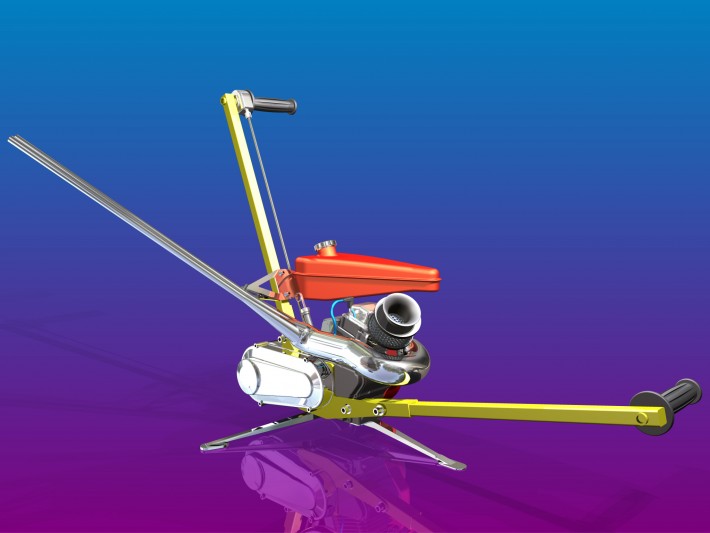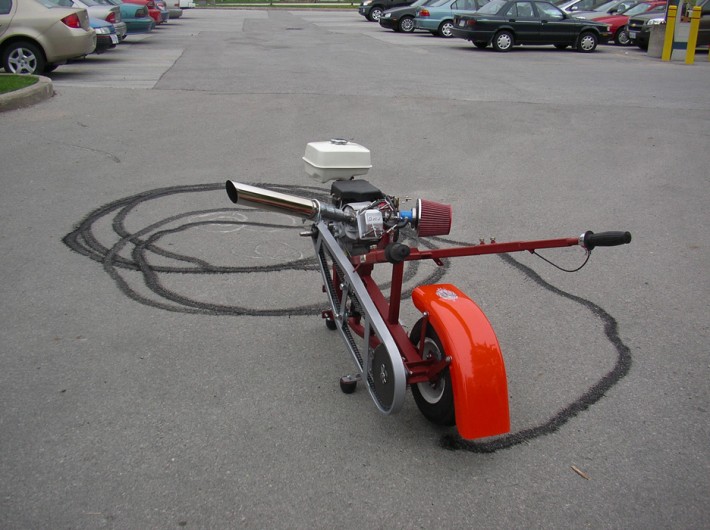Dragstrip Courage
by Chris Down
The object looks something like a cross between a recumbent rowing machine and a chopper. An engine mounted on a steel frame, a low-slung seat, chrome running boards, a cup holder, a tachometer, a forward facing muffler, a gas pedal. It is a machine that is meant to operate, to function. The utterly descriptive title of the work is Stationary Revving Machine: it is designed to let the engine rev while remaining stationary.
Like a dragster at the starting line or a 1976 Trans Am at a red light, this machine makes itself heard and seen and smelled, a wildly obnoxious and playful transgression of the often church-like atmosphere of an art viewing experience. When performed, the Stationary Revving Machine fills a space with the sounds of the engine, with smoke and fumes. As a sculptural object it sits as if ready to become active. Its metal surfaces gleaming, it evokes the same sense of power that leads car manufacturers to names like Barracuda, Mustang, or Firebird.
And yet, while the undoubtedly ecstatic activity of revving an engine brings to mind all of these images of car culture, there is something undeniably pathetic at work as well. The machine revs up to remain stationary, going nowhere, not unlike Wile E. Coyote mindlessly pumping his legs after he’s followed the Roadrunner off the cliff. The Stationary Revving Machine is ludicrously phallic but without even the marginal utility of a muscle car – you can’t use this machine to get groceries or go to work or drive to the campsite with a cooler full of beer in the trunk.
As with all of Steven Laurie’s ‘machine works’, the Stationary Revving Machine is operational, but its operation is not productive of tangible results outside of the noise and smells of the revving engine. Although these objects are often based on commonplace tools of home maintenance, they don’t function as tools in the expected way. They “work” when performed. That is, they rev or burn rubber or rip grass, but they don’t mow the lawn, or tamp down dirt, or blow leaves. Most of the work that they do is through signification, so that even when they are idle, they are self-explanatory, they narrate themselves.
The machines are hybrids. They are assembled from various parts such as lawnmower engines and import car mufflers, and cobbled together onto frames or chassis that Laurie welds in a particular configuration depending on his idea of how the machine should relate to his body when it is performed. They are modified ready-mades, but more in the tradition of custom dragsters than of Marcel Duchamp. They derive in part from the attention that Laurie pays to the culture around him, particularly that of street racing, of weekend mechanics and backyard tinkerers.
His relation to these activities is not merely that of a pop culture flaneur, although he is also that, but rooted in his experiences growing up in Whitby, Ontario. He says of the impetus for the Posi-track Rubber Burner “my Mom’s boyfriend used to buy muscle cars and do them up, and I remember one time helping him make an SS Chevelle into a posi-track, so when you take off you don’t go to one side. All dragsters lock up the back wheels so that they turn at the same time, so you go straight when you take off. So the thing that’s nice about it is when you take off you leave these two big black patches rather than one. So, I just made this machine that allows you to do two parallel lines. It’s sort of like an overdone lawnmower, the two tires actually make a really nice squawking sound.”*
The machines “work” as in function, but don’t work as in “produce”. So what, exactly, is the nature of their working? They are on the threshold of practicality in that they strongly resemble tools like lawnmowers or rototillers, but their use has no productive consequences. The struggle to build the machines, which are all prototypes, is echoed in the struggle to operate them. There is an awkward way in which Laurie’s body relates to each machine as it is performed, and this awkwardness focuses attention on the activities themselves. Why would someone go to the trouble of building the Donut Machine, when all it does is go in circles, leaving a black patch behind it? Or the Ape Hanger Rumbler, which merely sends pleasurable vibrations through the user’s body? Each machine/performance isolates a particular action that has to do with showing off or blowing off steam in a very specifically masculine way.
On one hand the machines are aggressive, loud and obnoxious while on the other they are humourous; they resemble everyday tools from the world of work, but they are meant to be played with like toys. The crux of these dualities lies in our cultural constructs of masculinity. “Real” men work hard and play hard as we are told in beer commercials, truck commercials, movies, books, magazines, email spam, by our sports teams, our friends, our brothers and fathers. The archetypal “real man” in our culture is little more than a caricature, and Laurie’s machines are both critical and celebratory of this image. This is because while the caricature is damagingly reductive, it is also the truth, on some level, of our experience as men.
If this weren’t the case, the 1970’s disco group The Village People, wouldn’t have had such resonance as a lampoon. The butch characters in this group – Policeman, Construction Worker, Cowboy, Indian, Biker – are icons of heterosexual masculinity, and each is inhabited as a kind of drag by gay performers. Similarly, Steven Laurie’s machines and performances are a type of drag where the identity of masculinity with work and machismo is both highlighted and undermined. The longer one revs an engine while stationary, the more absurd and futile the action becomes.
Work and performance are two terms that bracket Laurie’s practice. The custom work that builds these machines is rooted not only in the reality of blue collar labour and mundane chores but also in an ethic that knows the world through the ability to use one’s hands, through skill. It involves a construction of gender that is in some ways constantly at the stage of prototype rather than stereotype, where the work of modification is as much on readymade notions of masculinity as it is on readymade engine parts.
*studio interview with the artist, November 2009
[Essay written for Jacked! catalogue]


